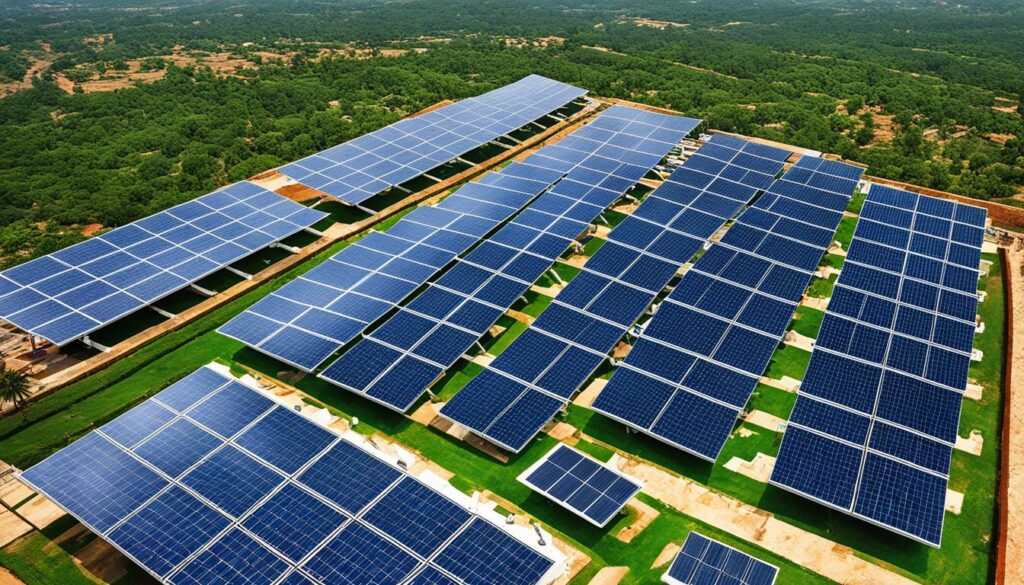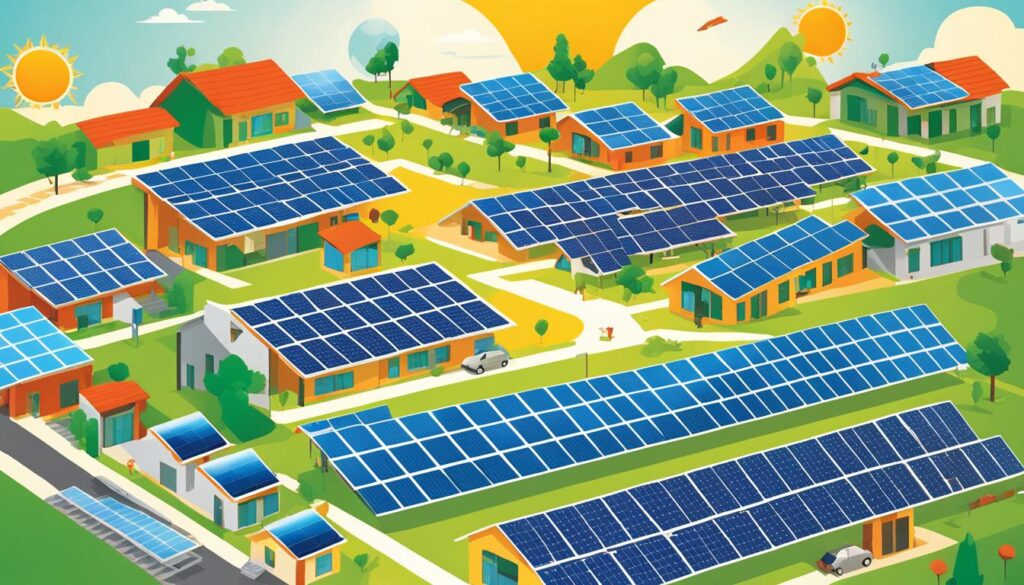Solar energy is a renewable energy source that has gained immense popularity in recent years as a cleaner, more sustainable alternative to traditional fossil fuels.
In this section, we will explore the four main types of solar energy commonly used in India: Photovoltaic (PV) Solar Energy, Solar Thermal Energy (STE), Concentrated Solar Power (CSP), and Passive Solar Energy. These types of solar energy offer different methods of harnessing the power of the sun for electricity generation and heating purposes.
Key Takeaways:
- India utilizes different types of solar energy for electricity generation and heating purposes.
- The four main types of solar energy used in India are Photovoltaic (PV) Solar Energy, Solar Thermal Energy (STE), Concentrated Solar Power (CSP), and Passive Solar Energy.
- Photovoltaic (PV) solar energy converts sunlight into electricity through the use of solar panels.
- Solar Thermal Energy (STE) and Concentrated Solar Power (CSP) harness the sun’s heat for various applications, including water heating, space heating, and electricity generation.
- Passive Solar Energy uses natural light and heat from the sun to warm buildings without the need for active mechanical systems.
Photovoltaic (PV) Solar Energy
Photovoltaic (PV) solar energy is a type of solar energy that involves converting sunlight into electricity through the use of solar panels. These solar panels contain photovoltaic cells that directly convert sunlight into direct current (DC) electricity. This electricity can then be converted into alternating current (AC) electricity for use in homes, businesses, and other electrical applications.
The key component of photovoltaic solar energy is the solar panel. Solar panels are made up of multiple photovoltaic cells, which are typically made from different materials such as monocrystalline, polycrystalline, or amorphous silicon, as well as other thin-film semiconductor materials. These materials have unique properties that affect the performance and efficiency of the solar panels.
Monocrystalline solar cells are made from a single crystal structure, which allows them to have higher efficiency and power output. Polycrystalline solar cells, on the other hand, are made from multiple crystal structures, which make them more cost-effective. Amorphous silicon solar cells are made from non-crystalline silicon and are known for their flexibility and ease of integration into various applications.
Photovoltaic solar energy is a modular and scalable technology, which means it can be used in various installations, from large-scale photovoltaic plants that generate utility-scale solar electricity to small rooftop panels on residential buildings. It is a clean and sustainable source of energy that reduces reliance on traditional fossil fuels, helps combat climate change, and provides a renewable source of electricity.

Achieving energy independence and reducing carbon emissions are key goals for India’s sustainable future. Photovoltaic solar energy offers a viable solution by harnessing the sun’s abundant power to generate clean electricity. Whether it’s large-scale solar farms or individual rooftop panels, photovoltaic solar energy is paving the way for a brighter and greener India.
Solar Thermal Energy (STE) and Concentrated Solar Power (CSP)
Solar thermal energy is a versatile form of renewable energy that harnesses the power of the sun to generate heat for various applications. It is particularly useful for solar water heating, space heating, and cooling systems, providing sustainable alternatives to traditional energy sources.
There are different technologies used to harness solar thermal energy. Transpired collectors, for example, passively absorb solar radiation to heat air, which can be used for space heating and ventilation. Solar collectors, on the other hand, use a circulation system to transfer heat from the sun to a fluid, which can then be stored or utilized for various purposes.
One notable technology in the field of solar thermal energy is Concentrated Solar Power (CSP). CSP systems use mirrors or lenses to concentrate solar radiation onto a receiver, generating intense heat. This heat can be used to produce steam, which, in turn, drives a turbine to generate electricity. CSP is especially useful for large-scale applications and thermal-fired power plants.
CSP systems often utilize thermal energy storage technologies, such as molten salts. These salts can store heat for extended periods, allowing CSP plants to continue generating electricity even when the sun is not shining. This storage capability contributes to the reliability and flexibility of concentrated solar power.
Incorporating solar thermal energy and concentrated solar power into the energy mix can significantly reduce greenhouse gas emissions and promote sustainable development.
Here is a table summarizing the key characteristics of solar thermal energy and concentrated solar power:
| Solar Thermal Energy (STE) | Concentrated Solar Power (CSP) |
|---|---|
| Harnesses solar energy to generate heat for various applications | Uses mirrors or lenses to concentrate solar radiation onto a receiver |
| Applications include solar water heating, space heating, and cooling systems | Mainly used for large-scale electricity generation |
| Utilizes technologies such as transpired collectors and solar collectors | Produces intense heat to generate steam for driving turbines |
| Can store thermal energy in various mediums for continuous operation | Efficiently utilizes solar radiation to generate electricity |
By harnessing solar thermal energy and concentrated solar power, we can tap into the vast potential of the sun to meet our energy needs sustainably and reduce our dependence on fossil fuels.
Passive Solar Energy and Building-Integrated Photovoltaics (BIPV)
Passive solar energy is a sustainable approach to building design and energy efficiency that harnesses the natural light and heat from the sun. By incorporating features such as large windows, thermal mass materials, and natural ventilation, passive solar design maximizes the benefits of solar energy for natural lighting, heating, and cooling purposes.
This solar design strategy is especially beneficial in a country like India, where sunlight is abundant throughout the year. By optimizing the use of natural light, passive solar energy reduces the need for artificial lighting during the day, saving energy and lowering electricity bills. Additionally, the natural heating provided by passive solar design reduces the reliance on mechanical heating systems, resulting in further energy savings.
Incorporating passive solar energy principles in buildings not only promotes energy efficiency but also enhances occupant comfort and well-being. By allowing ample natural light into the interior spaces, passive solar design creates a healthier and more pleasant environment. Furthermore, the use of building-integrated photovoltaics (BIPV) takes passive solar design to the next level.
BIPV integrates solar panels directly into building components, such as the roof, walls, or windows. These photovoltaic panels generate electricity from the sun while seamlessly blending into the building’s architecture. This innovative approach to solar energy not only produces clean and renewable power but also adds an aesthetically appealing element to the building’s design.
Moreover, BIPV presents an opportunity for sustainable development, particularly in commercial buildings, malls, and eco-friendly homes where solar-powered buildings are on the rise. By utilizing building-integrated photovoltaics, these structures can generate their own electricity, contributing to a greener, more sustainable future.
FAQ
What is solar energy?
Solar energy is a renewable energy source that utilizes the power of the sun to generate electricity or heat.
What are the various types of solar power used in India?
The main solar energy types used in India are Photovoltaic (PV) Solar Energy, Solar Thermal Energy (STE), Concentrated Solar Power (CSP), and Passive Solar Energy.
What is Photovoltaic (PV) Solar Energy?
Photovoltaic (PV) solar energy is obtained by converting sunlight into electricity through the use of solar panels.
How do solar panels work?
Solar panels contain photovoltaic cells that convert sunlight into direct current (DC) electricity, which can be converted into usable alternating current (AC) electricity.
What materials are used to make photovoltaic cells?
Photovoltaic cells can be made from materials like monocrystalline, polycrystalline, amorphous silicon, or other thin-film semiconductor materials.
What is Solar Thermal Energy (STE)?
Solar thermal energy is the conversion of solar energy into heat, which can be used for various applications such as heating water or spaces.
How do solar thermal systems work?
Solar thermal systems utilize technologies like transpired collectors, solar collectors, and thermally activated cooling systems to harness the heat from the sun.
What is Concentrated Solar Power (CSP)?
Concentrated Solar Power (CSP) is a type of solar thermal energy that uses mirrors or lenses to focus solar radiation onto a receiver, generating high-temperature heat.
How is CSP used to generate electricity?
The heat generated by CSP systems is used to produce steam, which is then used to drive a turbine and generate electrical power.
Can CSP systems generate electricity even at night?
CSP systems can store thermal energy in molten salts, allowing them to continue generating electricity even when the sun is not shining.
What is Passive Solar Energy?
Passive solar energy refers to the use of natural light and heat from the sun to warm a building or space without the use of active mechanical systems.
How does passive solar design work?
Passive solar design incorporates features like large windows for maximum sun exposure, thermal mass materials for heat storage, and natural ventilation for cooling.
What is Building-Integrated Photovoltaics (BIPV)?
Building-Integrated Photovoltaics (BIPV) is a type of solar energy that integrates photovoltaic panels into building components like roofs, walls, or windows.
What are the advantages of BIPV?
BIPV not only generates electricity but also enhances the energy efficiency and sustainability of buildings, making it a popular choice for commercial buildings and eco-friendly homes.

